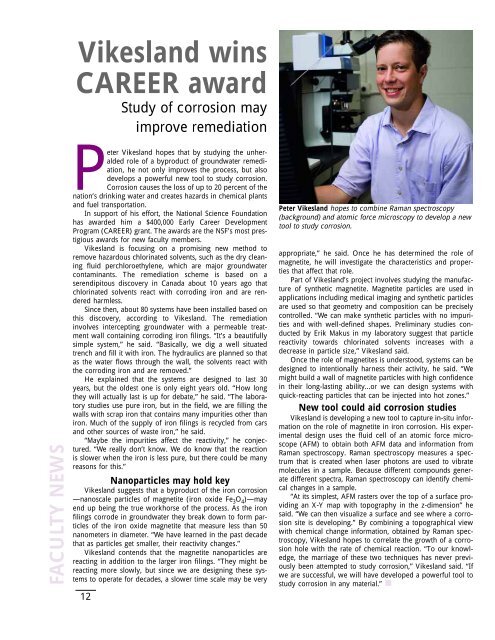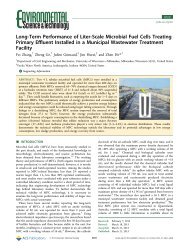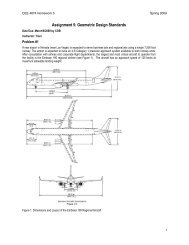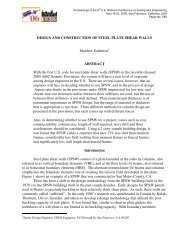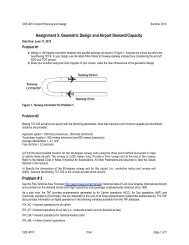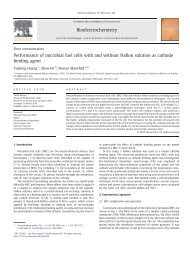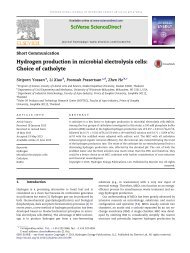Annual Report Year 2004 - Civil and Environmental Engineering
Annual Report Year 2004 - Civil and Environmental Engineering
Annual Report Year 2004 - Civil and Environmental Engineering
- No tags were found...
You also want an ePaper? Increase the reach of your titles
YUMPU automatically turns print PDFs into web optimized ePapers that Google loves.
Vikesl<strong>and</strong> winsCAREER awardStudy of corrosion mayimprove remediationFACULTY NEWSPeter Vikesl<strong>and</strong> hopes that by studying the unheraldedrole of a byproduct of groundwater remediation,he not only improves the process, but alsodevelops a powerful new tool to study corrosion.Corrosion causes the loss of up to 20 percent of thenation’s drinking water <strong>and</strong> creates hazards in chemical plants<strong>and</strong> fuel transportation.In support of his effort, the National Science Foundationhas awarded him a $400,000 Early Career DevelopmentProgram (CAREER) grant. The awards are the NSF’s most prestigiousawards for new faculty members.Vikesl<strong>and</strong> is focusing on a promising new method toremove hazardous chlorinated solvents, such as the dry cleaningfluid perchloroethylene, which are major groundwatercontaminants. The remediation scheme is based on aserendipitous discovery in Canada about 10 years ago thatchlorinated solvents react with corroding iron <strong>and</strong> are renderedharmless.Since then, about 80 systems have been installed based onthis discovery, according to Vikesl<strong>and</strong>. The remediationinvolves intercepting groundwater with a permeable treatmentwall containing corroding iron filings. “It’s a beautifullysimple system,” he said. “Basically, we dig a well situatedtrench <strong>and</strong> fill it with iron. The hydraulics are planned so thatas the water flows through the wall, the solvents react withthe corroding iron <strong>and</strong> are removed.”He explained that the systems are designed to last 30years, but the oldest one is only eight years old. “How longthey will actually last is up for debate,” he said. “The laboratorystudies use pure iron, but in the field, we are filling thewalls with scrap iron that contains many impurities other thaniron. Much of the supply of iron filings is recycled from cars<strong>and</strong> other sources of waste iron,” he said.“Maybe the impurities affect the reactivity,” he conjectured.“We really don’t know. We do know that the reactionis slower when the iron is less pure, but there could be manyreasons for this.”Nanoparticles may hold keyVikesl<strong>and</strong> suggests that a byproduct of the iron corrosion—nanoscale particles of magnetite (iron oxide Fe 3 O 4 )—mayend up being the true workhorse of the process. As the ironfilings corrode in groundwater they break down to form particlesof the iron oxide magnetite that measure less than 50nanometers in diameter. “We have learned in the past decadethat as particles get smaller, their reactivity changes.”Vikesl<strong>and</strong> contends that the magnetite nanoparticles arereacting in addition to the larger iron filings. “They might bereacting more slowly, but since we are designing these systemsto operate for decades, a slower time scale may be very12Peter Vikesl<strong>and</strong> hopes to combine Raman spectroscopy(background) <strong>and</strong> atomic force microscopy to develop a newtool to study corrosion.appropriate,” he said. Once he has determined the role ofmagnetite, he will investigate the characteristics <strong>and</strong> propertiesthat affect that role.Part of Vikesl<strong>and</strong>’s project involves studying the manufactureof synthetic magnetite. Magnetite particles are used inapplications including medical imaging <strong>and</strong> synthetic particlesare used so that geometry <strong>and</strong> composition can be preciselycontrolled. “We can make synthetic particles with no impurities<strong>and</strong> with well-defined shapes. Preliminary studies conductedby Erik Makus in my laboratory suggest that particlereactivity towards chlorinated solvents increases with adecrease in particle size,” Vikesl<strong>and</strong> said.Once the role of magnetites is understood, systems can bedesigned to intentionally harness their activity, he said. “Wemight build a wall of magnetite particles with high confidencein their long-lasting ability...or we can design systems withquick-reacting particles that can be injected into hot zones.”New tool could aid corrosion studiesVikesl<strong>and</strong> is developing a new tool to capture in-situ informationon the role of magnetite in iron corrosion. His experimentaldesign uses the fluid cell of an atomic force microscope(AFM) to obtain both AFM data <strong>and</strong> information fromRaman spectroscopy. Raman spectroscopy measures a spectrumthat is created when laser photons are used to vibratemolecules in a sample. Because different compounds generatedifferent spectra, Raman spectroscopy can identify chemicalchanges in a sample.“At its simplest, AFM rasters over the top of a surface providingan X-Y map with topography in the z-dimension” hesaid. “We can then visualize a surface <strong>and</strong> see where a corrosionsite is developing.” By combining a topographical viewwith chemical change information, obtained by Raman spectroscopy,Vikesl<strong>and</strong> hopes to correlate the growth of a corrosionhole with the rate of chemical reaction. “To our knowledge,the marriage of these two techniques has never previouslybeen attempted to study corrosion,” Vikesl<strong>and</strong> said. “Ifwe are successful, we will have developed a powerful tool tostudy corrosion in any material.”


